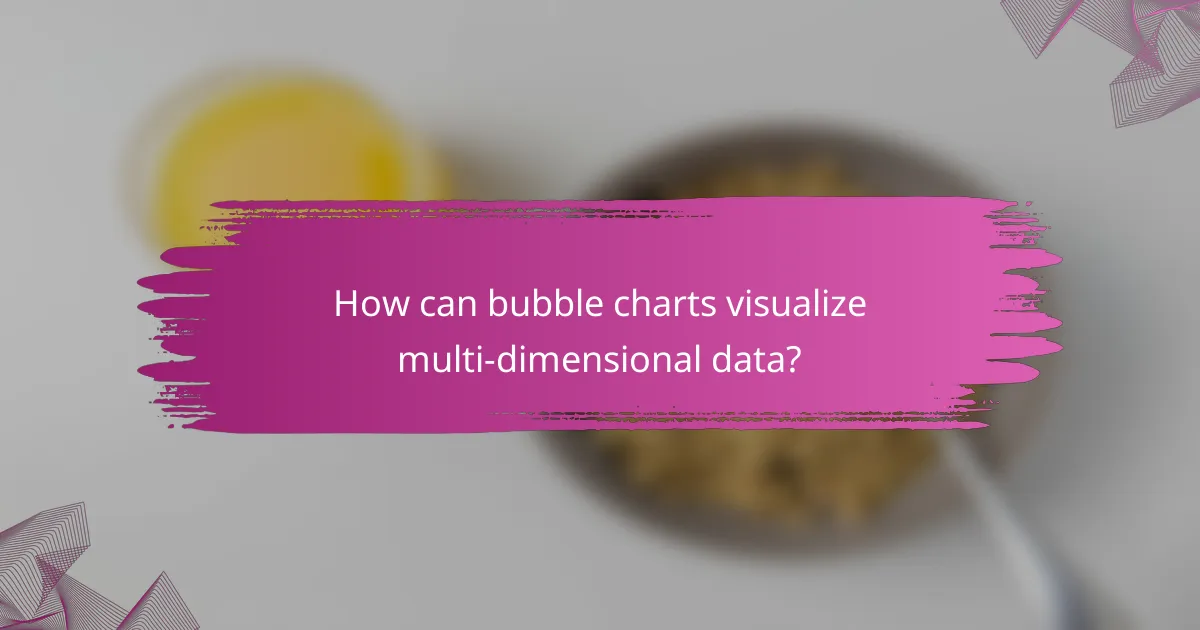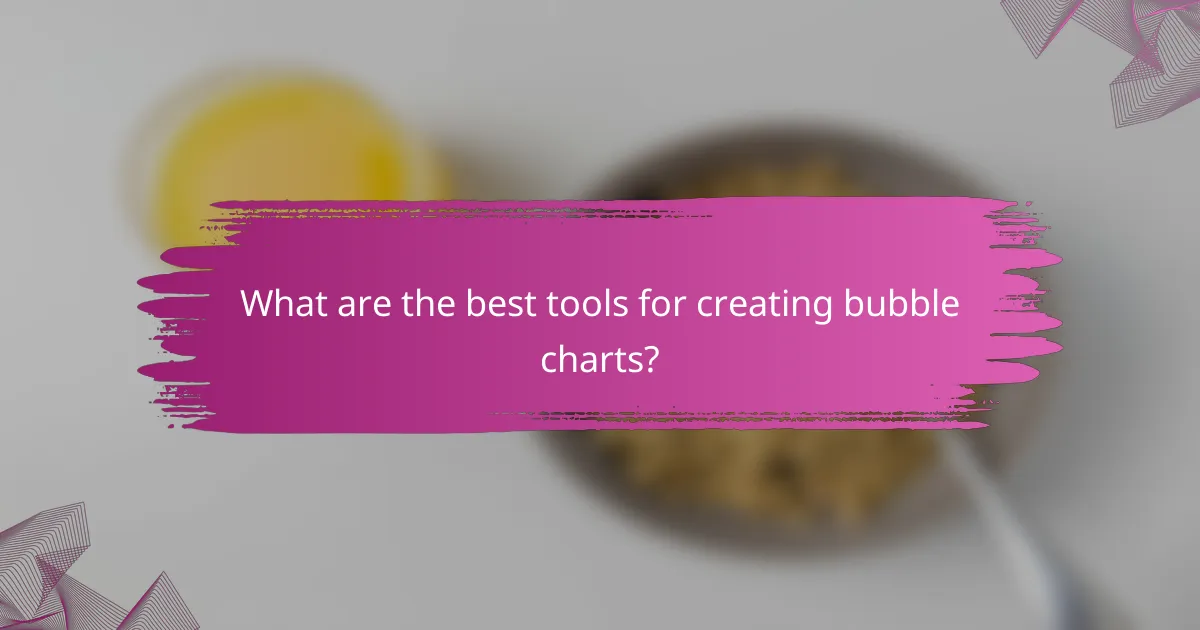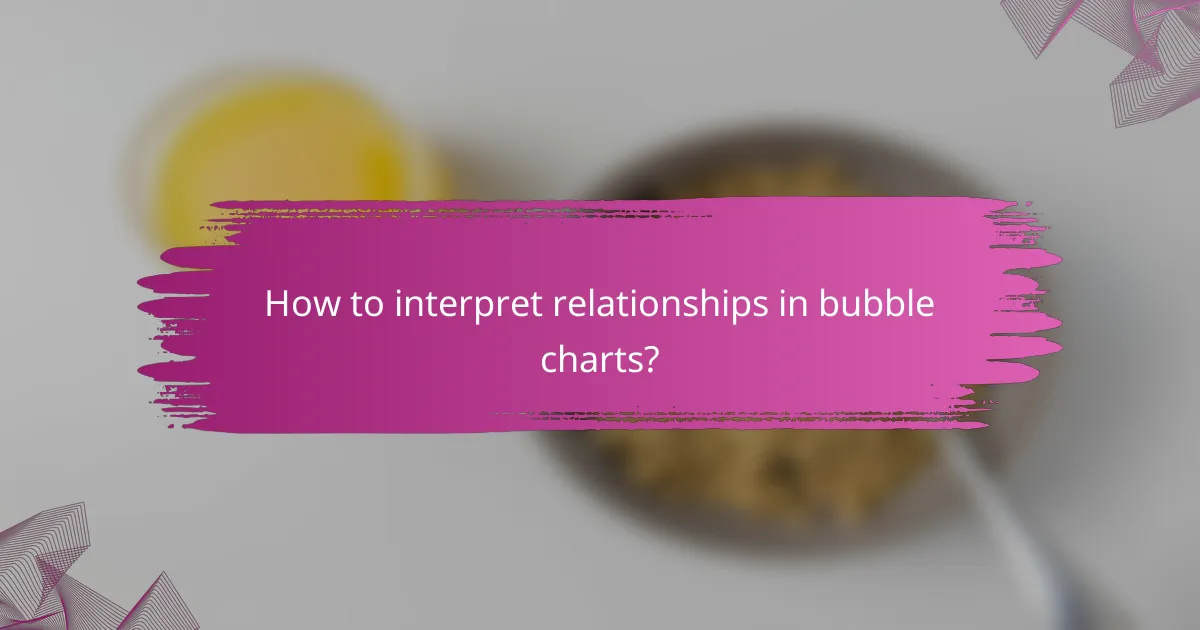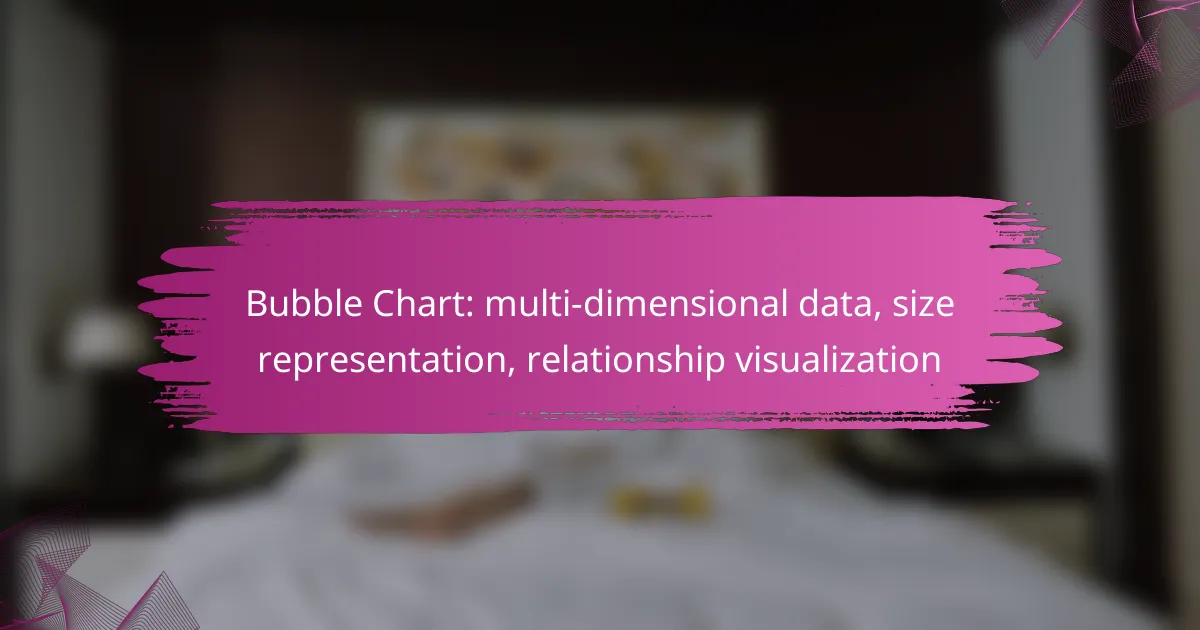Bubble charts are a powerful tool for visualizing multi-dimensional data, effectively representing three variables through position, size, and color. By illustrating relationships and magnitudes among data points, they facilitate a deeper understanding of correlations, clusters, and outliers in a single, cohesive view.

How can bubble charts visualize multi-dimensional data?
Bubble charts effectively visualize multi-dimensional data by representing three variables through the use of position, size, and color. This allows for a clear comparison of relationships and magnitudes among different data points in a single view.
Representation of three variables
In a bubble chart, the x-axis and y-axis typically represent two variables, while the size of the bubbles conveys a third variable. For example, in a chart comparing countries, the x-axis could represent GDP, the y-axis could represent population, and the bubble size could indicate the level of carbon emissions. This multi-faceted representation helps to uncover patterns and correlations that might not be apparent in simpler charts.
Size indicating magnitude
The size of each bubble in a bubble chart is crucial for conveying the magnitude of the third variable. Larger bubbles represent higher values, while smaller bubbles indicate lower values. For instance, if the size represents sales volume, a bubble that is significantly larger than others suggests that particular category or entity has much higher sales. This visual cue allows viewers to quickly assess the relative importance of different data points.
Color coding for categories
Color coding in bubble charts enhances the ability to distinguish between different categories or groups within the data. By assigning distinct colors to various categories, such as regions or product types, viewers can easily identify trends and outliers. For example, using shades of blue for one category and shades of red for another can help in quickly recognizing how different groups compare across the plotted dimensions.

What are the best tools for creating bubble charts?
The best tools for creating bubble charts include Tableau, Microsoft Excel, and Google Charts. Each tool offers unique features suited for different levels of complexity and interactivity, allowing users to visualize multi-dimensional data effectively.
Tableau for interactive visualizations
Tableau excels in creating interactive bubble charts that allow users to explore data dynamically. Its drag-and-drop interface makes it easy to manipulate data dimensions and measures, enabling users to adjust the size and color of bubbles based on various metrics.
Consider using Tableau if you need to present data in a visually engaging way, especially in professional settings. It supports large datasets and offers extensive customization options, making it ideal for detailed analysis and presentations.
Microsoft Excel for basic charts
Microsoft Excel is a widely accessible tool for creating basic bubble charts, suitable for users who need straightforward visualizations without advanced features. Users can easily input data and select the bubble chart option from the chart types available.
While Excel’s capabilities are limited compared to specialized software, it is sufficient for simple analyses and quick presentations. Ensure your data is well-organized in rows and columns to facilitate easy chart creation.
Google Charts for web integration
Google Charts is a powerful tool for creating bubble charts that can be easily integrated into web applications. It allows for real-time data updates and interactive features, making it suitable for online dashboards and reports.
Using Google Charts is beneficial if you want to share visualizations online without requiring users to download software. The tool is free to use and supports various customization options, ensuring that your charts can be tailored to fit your website’s design.

How to interpret relationships in bubble charts?
Bubble charts visually represent relationships between multiple dimensions of data, where the size of each bubble indicates a specific value. Understanding these relationships involves identifying correlations, recognizing data clusters, and analyzing outliers.
Identifying correlations
Correlations in bubble charts can be observed by examining the positioning of bubbles relative to each other. When bubbles are close together, it often indicates a positive correlation, while those that are further apart may suggest a negative or no correlation.
For instance, if you plot sales revenue against advertising spend, a cluster of larger bubbles in the upper right quadrant may signify that increased advertising correlates with higher sales. Look for trends in the direction of the bubbles to assess the strength and nature of the relationship.
Understanding data clusters
Data clusters in bubble charts reveal groups of related data points that share similar characteristics. Identifying these clusters can help in understanding patterns and trends within the dataset.
For example, if you have a bubble chart displaying customer satisfaction against product price, a cluster of bubbles in the mid-price range with high satisfaction scores may indicate a sweet spot for pricing strategy. Recognizing these clusters can guide business decisions and marketing strategies.
Analyzing outliers
Outliers are bubbles that stand apart from the main clusters and can indicate anomalies or unique cases within the data. Analyzing these outliers is crucial as they can provide insights into exceptional performance or potential issues.
For instance, a bubble that represents a product with very high sales but low advertising spend might suggest an unexpected success or a need for further investigation. Always consider the context of outliers, as they can significantly influence overall interpretations of the data.

What are the advantages of using bubble charts?
Bubble charts offer a unique way to visualize multi-dimensional data by representing three variables through the use of bubbles. Their ability to convey complex relationships in a clear and engaging manner makes them a valuable tool for data analysis and presentation.
Clear representation of complex data
Bubble charts excel at displaying complex data sets by allowing viewers to see relationships between multiple variables simultaneously. The position of each bubble represents two variables, while the size of the bubble indicates a third variable, making it easier to identify patterns and correlations.
For example, in a bubble chart illustrating sales performance, the x-axis could represent time, the y-axis could represent revenue, and the bubble size could indicate the number of units sold. This format helps stakeholders quickly grasp the overall performance and identify trends.
Effective for presentations
In presentations, bubble charts can effectively summarize and communicate key insights without overwhelming the audience with excessive detail. Their visual nature captures attention and facilitates discussions around the data being presented.
When preparing a presentation, consider using bubble charts to highlight significant findings, such as market opportunities or customer demographics. This approach can lead to more engaging discussions and informed decision-making among team members.
Engagement through visual appeal
Bubble charts are visually striking and can enhance audience engagement by breaking the monotony of traditional charts and graphs. Their colorful and dynamic nature draws viewers in, making the data more relatable and easier to understand.
To maximize visual appeal, use contrasting colors for different data sets and ensure that the chart is not cluttered. A well-designed bubble chart can serve as a focal point in reports or dashboards, prompting further exploration of the data.

What are the limitations of bubble charts?
Bubble charts have several limitations that can hinder their effectiveness in visualizing multi-dimensional data. Key issues include overlapping bubbles, challenges in extracting precise values, and their unsuitability for certain data types.
Overlapping bubbles causing confusion
One significant limitation of bubble charts is the potential for overlapping bubbles, which can obscure data points and make interpretation difficult. When bubbles overlap, it becomes challenging to discern individual values, leading to misinterpretations of the data.
To mitigate this issue, consider using transparency or varying bubble sizes to enhance visibility. Additionally, interactive features that allow users to hover over or click on bubbles can provide more detailed information without cluttering the visual.
Difficulty in precise value extraction
Extracting precise values from bubble charts can be problematic due to the representation of data through size rather than exact figures. Viewers may struggle to accurately gauge the value of a bubble based solely on its size, which can lead to inaccuracies in data analysis.
To improve value extraction, consider providing a legend or data labels that display the exact values alongside the bubbles. This approach can help users quickly understand the data without relying solely on visual estimation.
Not suitable for all data types
Bubble charts are not universally applicable and may not effectively represent all types of data. For example, they are less effective for categorical data or when the number of data points is very high, as this can lead to overcrowding and confusion.
Before choosing a bubble chart, assess whether your data is suitable for this format. If your dataset includes many categories or requires precise comparisons, alternative visualization methods, such as bar charts or scatter plots, may be more appropriate.

How to choose the right bubble chart for your data?
Selecting the appropriate bubble chart depends on the dimensions of your data, the understanding of your audience, and the complexity of the chart. A well-chosen bubble chart can effectively visualize multi-dimensional data, highlighting relationships and trends clearly.
Assessing data dimensions
Begin by identifying the dimensions you want to represent in your bubble chart. Typically, a bubble chart can illustrate three dimensions: two on the x and y axes, and a third represented by the size of the bubbles. For example, if you are comparing sales data across different regions, you might use revenue for the x-axis, profit for the y-axis, and market share for bubble size.
Ensure that the data dimensions you choose are relevant to the insights you want to convey. If your data has more than three dimensions, consider simplifying it or using alternative visualization methods, as too many dimensions can lead to confusion.
Considering audience understanding
Tailor your bubble chart to the knowledge level of your audience. If your audience is familiar with data visualization, they may easily interpret complex charts. However, if they are less experienced, opt for simpler representations with clear labels and legends.
Provide context for the data being presented. Use annotations or tooltips to explain what each bubble represents, especially if the chart includes industry-specific terminology or metrics that may not be universally understood.
Evaluating chart complexity
Assess the complexity of your bubble chart by considering the number of data points and the clarity of the relationships you wish to illustrate. A chart with too many bubbles can become cluttered, making it difficult for viewers to discern patterns. Aim for a balance between detail and readability.
To maintain clarity, limit the number of bubbles to a manageable range, ideally between 10 and 30, depending on the context. If you find your chart becoming too complex, consider breaking it into multiple charts or using filters to focus on specific subsets of data.
